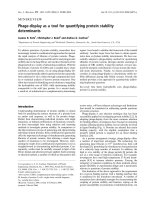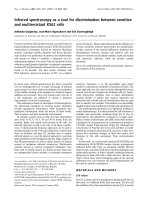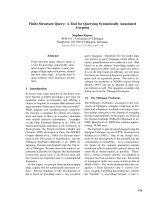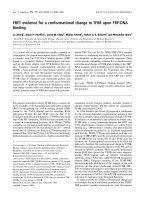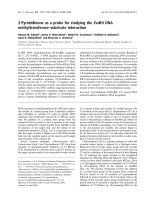Báo cáo khoa học: "VOCAL INTEILFACE FOR A MAN-MACHINE DIALOG " doc
Bạn đang xem bản rút gọn của tài liệu. Xem và tải ngay bản đầy đủ của tài liệu tại đây (367.75 KB, 6 trang )
VOCAL INTEILFACE FOR A MAN-MACHINE DIALOG
Dominique BEROULE
LIMSI (CNRS), B.P. 30, 91406 ORSAY CEDEX, FRANCE
ABSTRACT
We describe a dialogue-handling module used as
an interface between a vocal terminal and a task-
oriented device (for instance : a robot manipula-
ting blocks). This module has been specially desi-
gned to be implanted on a single board using micro-
processor, and inserted into the vocal terminal
which already comprises a speech recognition board
and a synthesis board. The entire vocal system is
at present capable of conducting a real time spo-
ken dialogue with its user.
I INTRODUCTION
A great deal of interest is actually being
shown in providing computer interfaces through dia-
log processing systems using speech input and out-
put (Levinson and Shipley, 1979). In the same time,
the amelioration of the microprocessor technology
has allowed the implantation of word recognition
and text-to-speech synthesis systems on single
boards (Li~nard and Mariani, 1982 ; Gauvain, 1983 ;
Asta and Li~nard, 1979) ; in our laboratory, such
modules have been integrated into a compact unit
that forms an autonomous vocal processor which has
applications in a number of varied domains : vocal
command of cars, of planes, office automation and
computer-aided learning (N~el et al., 1982).
Whereas most of the present language under-
standing systems require large computational re-
sources, our goal has been to implement a dialog-
handling board in the LIMSI's Vocal Terminal.
The use of micro-systems introduces memory si-
ze and real-time constraints which have incited us
to limit ourselves in the use of presently availa-
ble computational linguistic techniques. Therefore,
we have taken inspiration from a simple model of
semantic network ; for the same reasons, the ini-
tial parser based on an Augmented Transition Net-
work (Woods, 1970) and implemented on an IBM 370
(Memmi and Mariani, 1982) was replaced by another
less time- and memory-consuming one.
The work presented herein extends possible
application fields by allowing an interactive vocal
relation between the machine and its user for the
execution of a specific task : the application that
we have chosen is a man-machine communication with
a robot manipulating blocks and using a Plan Gene-
rating System.
SPEECH I
RECOGNIZER
SEMANTIC [ SYNTACTIC
PROCESSING ANALYSIS
SEMANTIC ]
TREATMENT
I 8"ANC"INO.,I
\
'I o .t.E I
.AsE QOEST,ON
i
i
i
l
I
I B
ASSERT~N ANSWER i
t
/./f
I
SENTENCE I !'
PRODUCTION (
t
(
SPEECH
J
SYNTHESIZER
Figure I. Block diagram of ~he system
II SYNTACTIC PROCESSING
A. Prediction Device
Once the acoustic processing of the speech si-
gnal is performed by the 250 word-based recognition
board, syntactic analysis is carried out.
It may be noted that response time and word
confusions increase with the vocabulary size of
word recognition systems. To limit the degradation
of performance, syntactic information is used :
words that can possibly follow a given word may be
predicted at each step of the recognition process
with the intention of reducing vocabulary.
43
B. Parameters Transfer
In order to build a representation of the deep
structure of an input sentence, parameters reque-
sted by the semanticprocedures must be filled with
the correct values. The parsing method that we de ~
velopped considers the naturel language utterances
as a set of noun phrases connected with function
words (prepositions, verbs ) which specify their
relationships. At the present time, the set of noun
phrases is obtained by segmenting the utterance at
each function word.
Sl
f
Le petit chat gris attrap~la souri~
J
SII •
S12
(the small grey cat is catching the mouse)
parameters :
O11 *-chat ~ 012 ~-souris
Pll *-(petit gris)
PI2*-NIL
$22
S11 • S12 ~$21 ~$221 ~
$222
Pr~-~end"la pyranlide et'posel~-~sur~egros cube"
t SI t
S2
(grasp the pyramid and put it on the big cub)
parameters :
X O11 NIL •
O21 *-NIL
PII*- NIL ~ P21 ~-NIL
V1 4 prendre { V2 4- poser
O12 *-pyramide • 0221÷pyramide
PI2 ~ (petite) X P221~(petite)
Figure 2. Parameters transfer
VI ~-attraper
0222 ~ cube
P222~- (gros)
III SEMANTIC PROCESSING
A. S[stem knowledge data
The computational semantic memory is inspired
by the Collins and Quillian model, a hierarchical
network in which each node represents a concept.
Properties can be assigned to each node, which al-
so inherits those of its ancestors. Our choice has
been influenced by the desire to design a system
which would be able to easily learn new conceptS ;
that is, to complete or to modify its knowledge
according to information coming from a vocal input/
output system.
Each noun of the vocabulary is represented by
a node in such a tree structure. The meaning of any
given verb is provided by rules that indicate the
type of objects that can be related. As far as ad-
jectives are concerned, they are arranged in exclu-
sive property groups.
Has skin
• ~ Can move around
Anlmmal A~.
Eats
BirdJ~ Can fly Fish'~Can swim
Is pink
/
\ ,as,oog /. an hi. Z,s edible
Can sing . thin legs
~Can, ,, Ostrich~thin ~ ~ gs Shark~ IS dange-
Sa I mon~",i~ S
p-
Is yellOW "- - ~ Is ~al
~_ . rous stream to
Canary Can't fly lay eggs
{C0]]ins & Quil|ian 1969)
Figure 3. Semantic memory model
The knowledge-based data (which may be enlar-
ged by information provided by the vocal channel)
is complemented by temporary data which chronologi-
cally contain, in abbreviated form, events evoked
during the dialogue.
B. Assertion processin~
The small amount of data representing a given
universe allows us to approach the computational
treatment of these two complementary and contrary
components of dialogue: learning and contestation.
Every time an assertion is proposed by the
user a procedure parses its semantic validity by
answering the question "Does this sentence fit with
the current state of the knowledge data ?". If a
contradiction is detected, it is pointed out to the
user who must justify his proposal. If the user
persists in his declaration, the machine may then
modify its universe knowledge, otherwise the utte-
rance is not taken into account.
When no contradiction is encountered, the pro-
gram enters into a learning process adding to the
temporary data or knowledge-based data.
User : Un poisson poss~de des plumes
(A fish has got feathers)
System : J'ai compris As-tu quelque chose
ajouter ?
(I have understood Would you like to
say something else ?)
U : Une truite poss~de des ~cailles
(A trout has got scales)
S : Je croyais qu'un poisson poss~dait des plumes
(I thought that a fish had got feathers)
U : Non (No)
S : D'accord (All right)
U : Qu'est-ce qu'un poisson ? (What is a fish ?)
S : C'est un animal qui poss~de des ~cailles
(It is an animal which has got scales)
44
I. Teaching utterances
These assertions, characterized by the pre-
sence of a non-action verb, permit both the com-
plete construction of the semantic network and of
the concept relation rules specifying the possible
entities that can serve as arguments for a predi-
cate.
Although most of our knowledge results from
long nurturing and frequent interactions with the
outside world, it is possible to give an approxi-
mate meaning to concrete objects and verbs by
using an elementary syntax. A new concept may be
taught by filling in its position within the se-
mantic network and possibly associating it with
properties that will differentiate it from its
brother nodes. Concept relation rules can be learn-
ed, too.
U : Le caf~ (coffee )
S : Qu'est ce qu'un caf~ (What is coffee)
U : Le caf~ ressemble ~ du lait
(Coffee looks like milk)
S :
U : Le caf~ est noir (coffee is black)
S : Je pense avoir compris ~ toi
(I think that I have understood )
U : Qu'est ce que du caf~ ? (What is coffee ?)
S : Le caf~ est un liquide noir
(Coffee is a black liquid)
U : Tu bois du caf~ (You are drinking coffee)
S : C'est impossible (It is impossible)
U : Un ordinateur peut boire un liquide
(A computer is able to drink a liquid)
S : C'est bon j'ai compris
(That's right I have understood)
U : Tu bois du caf~ (You are drinking coffee)
S : D'accord (Okay)
U : Qui bois du caf~ ? (Who is drinking coffee ?)
S : Je le bois (I am drinking it)
2. Descriptive utterances
Sentences involving an action verb are trans-
lated into an unambiguous representation which con-
denses and organizes information into the very same
form as that of the concept relation rules from
knowledge data. Therefore, semantic validity can be
easily tested by a pattern-matching process. A se-
mantic event reduced to a nested-triplet structure
and considered as valid is then inserted in the
dynamic-events memory, and can be requested later
on by the question-answering process.
Although the language is limited to a small
subset of natural French, several equivalent syn-
tactic structures are allowed to express a given
event ; in order to avoid storing multiple repre-
sentations of the same event, paraphrases of a given
utterance are reduced to a single standard form.
One of the task effected by a language under-
standing system consists of recognizing the concepts
that are evoked inside the input utterances. As
soon as ambiguities are detected, they are resolved
through interaction with the user.
U : Je prends le cube I (I am taking the cube I)
S : S'agit-il du petit cube I ?
(Is the small cube I in question ?)
U : ~i (Yes it is)
S:O.K.
Relative~ clauses are not represented in the
canonical form of the utterance in which they
appear, but they are only used to determine which
concept is in question.
article i - Nun ! - Adjective I - Verb - article 2 - Adjec. 2 - Nun 2
abbreviated form : @ (( NI A1 )( N2 A2 ))) = semantic event E
relation rule n ° i :
i p~2) )
((o~2 p~2) (022
E allowable (~ 3 (i,j) / V k = i, 2
i
V .= R
0 i
N k
E ~ (kj)
Pkj
E ~-~ (N k)
Pkj ~ Ak
Figure 4. Pattern-matching of a simple
sentence
Relation
Object
Property
(~ : Descendants)
{.~ : Property group)
(~ : Compatible with)
saisis les cubes 2 et 5 (grasp cubes 2 and 5)
prends le cube 2 et le 5
(take hold of the cube 2 and the 5 one)
attrape le cube 2 et saisis le cube 5
(lay hold of the cube 2 and grasp the cube 5)
canonical form :
(ASK((YOU)((TAKE((1)(CUBE(2))&(CUBE(5)))))))
Figure 5. Paraphrases translation
3. Orders
Input utterances beginning with an action verb
specify an order that the machine connected to the
vocal interface is supposed to execute ; in addi-
tion to the deep structure of this natural language
message, a formal command language message is built
and then sent to the machine. The task universe
memory is modified in order to reflect the execu-
tion of a user's command.
User : Prends la pyramide qui est sur la table et
pose. la sur le gros cube (grasp the pyramid
which is on the table and put it on the big
cube)
Machine : S'agit-il du gros cube 3 ?
(are you talking of the big cube 3 ?)
User : Oui (yes)
Machine : D'accord (all right)
Deep structure
45
(ASK((YOU)((TAKE((1)(PYRAMID(SMALL)))))
&((PUT((1)((ON((PYRAMID(SMALL))(CUBE(GROS 3))
formal command : ((HOLD PYR2)(ON PYR2 CUB3))
User : Qu'ai je fait (What did I do)
Deep structure : (DO ((YOU) ?)
Machine : Tu as demand~ que je prenne la petite
pyramide et que je pose la petite pyra-
mide sur le gros cube 3 (You have asked
me to grasp the small pyramid and put
the small pyramid on the big cube 3)
User : Quia saisi un objet (Who has taken an
object)
Deep structure : (TAKE ( ? (OBJ)))
Machine : J'ai pris la petite pyramide (I have
grasped the small pyramid)
User : Qu'as-tu fait apr~s ? (What have you done
afterwards ?)
Deep structure : (DO ((I) ?))
Machine : J'ai pos~ la petite pyramide sur le gros
cube 3 (I put the small pyramid on the
big cube 3)
C. Question processing
In everyday language, intonation often conti-
tutes the marker that discriminates between ques-
tions and assertions. Since prosody information is
not presently taken into account by the word recog-
nition system, the presence of an interrogative
pronoun switches on the information research pro-
cessing in permanent knowledge-data or in dynamic-
events memory.
I. Research in permanent knowledge-data
The program is allowed to express its know-
ledge at the user's request, for instance, on con-
cept meanings, or the systems abilities.
U : Qui es-tu ? (Who are you ?)
S : Je suis un ordinateur bavard (I am a talkative
computer)
U : Puis-je parler avec toi ?
(Can I speak with you ?)
S : Oui, c'est possible (Yes, that is possible)
U : Tu es une souris (You are a mouse)
S : Je pensais que j'~tais un ordinateur
(I thought that I was a computer)
U : C'est faux (That's false)
S : O.K.
U : Qui es-tu ? (Who are you ?)
S : Je suis une souris bavarde
(I am a talkative mouse)
U : Est-ce qu'un chat peut parler avec toi ?
(Is a cat able to speak with you ?)
S : Bien ~r que non (Of course not)
2. Research in d~na~nic-events data
The abbreviated semantic events list is close-
ly examined, from recent to older data, until the
question-pattern approximately matches one of the
memorized events. Possible analogy between a memo-
rized event and one evoked by the question is then
analysed. Coincidences rarely happen, so the system
must be able to ask for full specifications about
the event that interests the user ; at that time
there is a vocal discussion aimed at leading the
system to that event in a step-wise manner.
U : Une femme blonde cherche une brosse
( A blond woman is looking for a brush)
S : D'accord, je comprends (All right, I under-
stand)
U : Je cherche un peigne (I am looking for a comb)
S : Tr~s int~ressant (Very interesting )
U : Quel ~tre humain cherche quelque chose ?
(What human being is looking for something ?)
S : S'agit-il de toi ? (Are you talking about
yourself ?)
U : Non (No)
S : S'agit-il d'une femme blonde ? (Are you talking
about a blond woman ?)
U : Oui (Yes)
S : Elle cherche une brosse (She is looking for a
brush)
D. Processing a user's incomplete utterance
An important specific quality of the semantic
process is that it is able to accomodate bad acous-
tical recognition through intelligent interactive
feedback.
So, when one part of a given sentence has not
been recognized, because of mispronunciation or
background noise, the system produces a suitable
question bringing the user to repeat the unrecogni-
zed word within his answer.
Two cases can occur :
if the word is again unrecognized, the system
assumes that the entity is not in the prescribed
vocabulary (containing the acoustic features of
the words). An explanatory message is then produced
through the synthesis module.
if the lexical entity is well recognized this
time, it is added to the previous utterance and
computed in the same manner as the others.
U "
S •
U :
S :
S :
U :
S :
U :
S :
S :
U :
S :
Je (?) un livre (I am (?) a book)
Que fais-tu avec le livre ?
(What are you doing with the book)
Je le mange (I am eating it)
C'est impossible je ne te crois pas
(It is impossible I do not believe you)
Une (?) femme boit du th~
(A (?) woman is drinking tea)
Comment est la femme ? (What is the woman
like ?)
Elle est grande (She is tall)
O.K.
Est-ce qu'une fen~ne bolt du th~ ?
(Is a woman drinking tea ?)
Oui, la grande femme (Yes, a fat woman is)
Un honm~e lit un gros (?)
(A man is reading a thick (?))
Que lit-il ? (What is he reading ?)
Un gros livre (A thick book)
J'ai compris (I have understood)
46
U : Qui lit un livre ? (Who is reading a book ?)
S : Un homme lit un gros livre
(A man is reading a thick book)
When a certain amount of acoustical components
in a sentence have not been recognized, the system
asks for the user to repeat his assertion.
U : Le (?) (?) un petit (?)
s : Peux-tu r~p~ter s'il te plait ?
E. Sentence production
1.
Translation of a deep structure into an
output sentence
This process consists of inserting semantic
entities into the suitable syntactic diagram which
depends on the computational procedure that is ac-
tivated (question answering, contradiction, learn-
ing, asking for specifications ). Since each
syntactic variation of a word corresponds to a sin-
gle semantic representation, sentence generation
makes use of verb conjugation procedures and con-
cordance procedures.
In order to improve the natural quality of
speech, different types of sentences expressing one
same idea may be generated in a pseudo-random man-
ner. The same question asked to the system several
times can thus induce different formulated respon-
ses.
2. Text-to-speech transcription ambiguities
A module of the synthesis process takes any
French text and determines the elements necessary
for the diphone synthesis, with the help of a dic-
tionnary containing pronunciation rules and their
exceptions (Prouts, 1979). However, some ambigui-
ties concerning text-to-speech transcription can
still remain and cannot be resolved without syn-
tactico-semantic information ; for instance :
"Les poules du couvent couvent" (the convent hens
are sitting on their eggs) is pronounced by the
synthesizer : / I £ p u I d y k u v ~ k u v E /
(the convent hens ~onvent).
To deal with that problem, we may send the
synthesizer the phonetic form of the words.
IV CONCLUSION
The dialog experiment is presently running on
a PDP 11/23 MINC and on an INTEL development system
with a VLISP interpreter in real-time and using a
series interface with the vocal terminal.
The isolated word recognition board we are
using for the moment makes the user pause for appro-
ximately half a second between each word he pronoun-
ces. In the near future we plan to replace this
module by a connected word system which will make
the dialog more natural. It may be noted that the
compactness of the understanding program allows its
implantation on a microprocessor board which is to
be inserted in the vocal terminal.
At present we apply ourselves to make the
dialog-handling module easily adaptable to various
domains of application.
D
1
MACHINE
Figure 6. Multibus configuration of the
Vocal Terminal
Acknowledgements
We are particulary grateful to Daniel MEMMI,
Jean-Luc GAUVAIN and Joseph MARIANI for their pre-
cious help during the course of this work. Special
thanks to Maxine ESKENAZI, Fran~oise NEEL and
Mich~le CHASTAGNER.
REFERENCES
V. ASTA, J.S. LIENARD - L'icophone logiciel : un
synth~tiseur par formes d'ondes - 10e JEP,
Grenoble, 1979.
E. CHARNIAK, Y. WILKS (editors) - Computational
Semantics - North-Holland, 1976.
A.M. COLLINS, M.R. QUILLIAN - Retrieval time from
semantic memory - Journal of Verbal Learning
and Verbal Behavior, 1969.
J.L. GAUVAIN -
Reconnaissance de mots enchaln~s et
d~tection de mots dans la parole continue -
Th~se 3e cycle, Orsay, 1982.
S.E. LEVINSON, K.L. SHIPLEY - A conversational
system using speech input end output -
The Bell System Technical Journal, vol. 59,
n ° I, january 1980.
J.S. LIENARD, J.J. MARIANI - Syst~me de reconnais-
sance de mots isol~s : MOISE - Registred
Technical Report ANVAR n ° 50312, juin 1980.
47
D. MEMMI, J.J. MARIANI - ARBUS : A tool for deve-
loping application grammars - Coling, Prague,
1982.
F. NEEL, J.S. LIENARD, J.J. MARIANI - An experiment
of vocal con~nunicatinn applied to computer-
aided learning - IFIP WCCES], juillet 1981.
B. PROUTS - Traduction phon~tique de textes ~crits
en frangais - l Oe JEP, Grenoble, 1979.
R. SCHANK - Conceptual information processing -
North Holland, 1975.
T. WINOGRAD -
Understanding natural language -
Academic Press, 1972.
W.A. WOODS -
Transition network grammar for natu-
ral language analysis - Communication of the
ACM, vol. 13, n ° I0, 1970.
48

